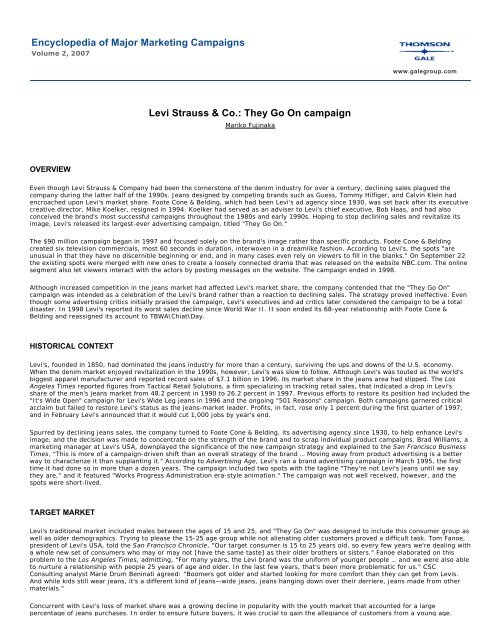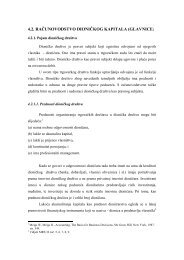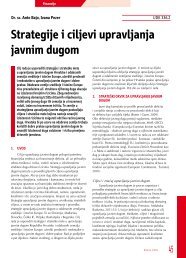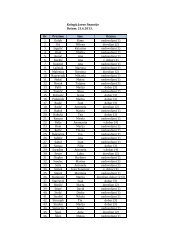Levi Strauss & Co.: They Go On campaign Encyclopedia of Major ...
Levi Strauss & Co.: They Go On campaign Encyclopedia of Major ...
Levi Strauss & Co.: They Go On campaign Encyclopedia of Major ...
Create successful ePaper yourself
Turn your PDF publications into a flip-book with our unique Google optimized e-Paper software.
<strong>Encyclopedia</strong> <strong>of</strong> <strong>Major</strong> Marketing Campaigns<br />
Volume 2, 2007<br />
OVERVIEW<br />
<strong>Levi</strong> <strong>Strauss</strong> & <strong>Co</strong>.: <strong>They</strong> <strong>Go</strong> <strong>On</strong> <strong>campaign</strong><br />
Mariko Fujinaka<br />
Even though <strong>Levi</strong> <strong>Strauss</strong> & <strong>Co</strong>mpany had been the cornerstone <strong>of</strong> the denim industry for over a century, declining sales plagued the<br />
company during the latter half <strong>of</strong> the 1990s. Jeans designed by competing brands such as Guess, Tommy Hilfiger, and Calvin Klein had<br />
encroached upon <strong>Levi</strong>'s market share. Foote <strong>Co</strong>ne & Belding, which had been <strong>Levi</strong>'s ad agency since 1930, was set back after its executive<br />
creative director, Mike Koelker, resigned in 1994. Koelker had served as an adviser to <strong>Levi</strong>'s chief executive, Bob Haas, and had also<br />
conceived the brand's most successful <strong>campaign</strong>s throughout the 1980s and early 1990s. Hoping to stop declining sales and revitalize its<br />
image, <strong>Levi</strong>'s released its largest-ever advertising <strong>campaign</strong>, titled "<strong>They</strong> <strong>Go</strong> <strong>On</strong>."<br />
The $90 million <strong>campaign</strong> began in 1997 and focused solely on the brand's image rather than specific products. Foote <strong>Co</strong>ne & Belding<br />
created six television commercials, most 60 seconds in duration, interwoven in a dreamlike fashion. According to <strong>Levi</strong>'s, the spots "are<br />
unusual in that they have no discernible beginning or end, and in many cases even rely on viewers to fill in the blanks." <strong>On</strong> September 22<br />
the existing spots were merged with new ones to create a loosely connected drama that was released on the website NBC.com. The online<br />
segment also let viewers interact with the actors by posting messages on the website. The <strong>campaign</strong> ended in 1998.<br />
Although increased competition in the jeans market had affected <strong>Levi</strong>'s market share, the company contended that the "<strong>They</strong> <strong>Go</strong> <strong>On</strong>"<br />
<strong>campaign</strong> was intended as a celebration <strong>of</strong> the <strong>Levi</strong>'s brand rather than a reaction to declining sales. The strategy proved ineffective. Even<br />
though some advertising critics initially praised the <strong>campaign</strong>, <strong>Levi</strong>'s executives and ad critics later considered the <strong>campaign</strong> to be a total<br />
disaster. In 1998 <strong>Levi</strong>'s reported its worst sales decline since World War II. It soon ended its 68-year relationship with Foote <strong>Co</strong>ne &<br />
Belding and reassigned its account to TBWA\Chiat\Day.<br />
HISTORICAL CONTEXT<br />
<strong>Levi</strong>'s, founded in 1850, had dominated the jeans industry for more than a century, surviving the ups and downs <strong>of</strong> the U.S. economy.<br />
When the denim market enjoyed revitalization in the 1990s, however, <strong>Levi</strong>'s was slow to follow. Although <strong>Levi</strong>'s was touted as the world's<br />
biggest apparel manufacturer and reported record sales <strong>of</strong> $7.1 billion in 1996, its market share in the jeans area had slipped. The Los<br />
Angeles Times reported figures from Tactical Retail Solutions, a firm specializing in tracking retail sales, that indicated a drop in <strong>Levi</strong>'s<br />
share <strong>of</strong> the men's jeans market from 48.2 percent in 1990 to 26.2 percent in 1997. Previous efforts to restore its position had included the<br />
"It's Wide Open" <strong>campaign</strong> for <strong>Levi</strong>'s Wide Leg jeans in 1996 and the ongoing "501 Reasons" <strong>campaign</strong>. Both <strong>campaign</strong>s garnered critical<br />
acclaim but failed to restore <strong>Levi</strong>'s status as the jeans-market leader. Pr<strong>of</strong>its, in fact, rose only 1 percent during the first quarter <strong>of</strong> 1997,<br />
and in February <strong>Levi</strong>'s announced that it would cut 1,000 jobs by year's end.<br />
Spurred by declining jeans sales, the company turned to Foote <strong>Co</strong>ne & Belding, its advertising agency since 1930, to help enhance <strong>Levi</strong>'s<br />
image, and the decision was made to concentrate on the strength <strong>of</strong> the brand and to scrap individual product <strong>campaign</strong>s. Brad Williams, a<br />
marketing manager at <strong>Levi</strong>'s USA, downplayed the significance <strong>of</strong> the new <strong>campaign</strong> strategy and explained to the San Francisco Business<br />
Times, "This is more <strong>of</strong> a <strong>campaign</strong>-driven shift than an overall strategy <strong>of</strong> the brand … Moving away from product advertising is a better<br />
way to characterize it than supplanting it." According to Advertising Age, <strong>Levi</strong>'s ran a brand advertising <strong>campaign</strong> in March 1995, the first<br />
time it had done so in more than a dozen years. The <strong>campaign</strong> included two spots with the tagline "<strong>They</strong>'re not <strong>Levi</strong>'s jeans until we say<br />
they are," and it featured "Works Progress Administration era-style animation." The <strong>campaign</strong> was not well received, however, and the<br />
spots were short-lived.<br />
TARGET MARKET<br />
www.galegroup.com<br />
<strong>Levi</strong>'s traditional market included males between the ages <strong>of</strong> 15 and 25, and "<strong>They</strong> <strong>Go</strong> <strong>On</strong>" was designed to include this consumer group as<br />
well as older demographics. Trying to please the 15-25 age group while not alienating older customers proved a difficult task. Tom Fanoe,<br />
president <strong>of</strong> <strong>Levi</strong>'s USA, told the San Francisco Chronicle, "Our target consumer is 15 to 25 years old, so every few years we're dealing with<br />
a whole new set <strong>of</strong> consumers who may or may not [have the same taste] as their older brothers or sisters." Fanoe elaborated on this<br />
problem to the Los Angeles Times, admitting, "For many years, the <strong>Levi</strong> brand was the uniform <strong>of</strong> younger people … and we were also able<br />
to nurture a relationship with people 25 years <strong>of</strong> age and older. In the last few years, that's been more problematic for us." CSC<br />
<strong>Co</strong>nsulting analyst Marie Drum Beninati agreed: "Boomers got older and started looking for more comfort than they can get from <strong>Levi</strong>s.<br />
And while kids still wear jeans, it's a different kind <strong>of</strong> jeans—wide jeans, jeans hanging down over their derriere, jeans made from other<br />
materials."<br />
<strong>Co</strong>ncurrent with <strong>Levi</strong>'s loss <strong>of</strong> market share was a growing decline in popularity with the youth market that accounted for a large<br />
percentage <strong>of</strong> jeans purchases. In order to ensure future buyers, it was crucial to gain the allegiance <strong>of</strong> customers from a young age.
Unfortunately for <strong>Levi</strong>'s, its market share with the consumer group <strong>of</strong> 15- to 19-year-olds dropped from 33 percent in 1993 to 26 percent in<br />
1997. <strong>Levi</strong>'s learned that this statistic was not a fluke when a yearlong research project indicated that the "echo boomers," children <strong>of</strong> baby<br />
boomers, considered <strong>Levi</strong>'s passé. Steve <strong>Go</strong>ldstein, vice president <strong>of</strong> marketing and research for <strong>Levi</strong>'s USA, told BusinessWeek, "Kids say<br />
they love the <strong>Levi</strong>'s brand. But if you ask them whether it's 'with it,' they'll say no." Sixteen-year-old Irma Cruz stated in the <strong>Co</strong>lumbian,<br />
"<strong>Levi</strong>'s are too straight, too plain … None <strong>of</strong> my friends wear them." <strong>Levi</strong>'s needed to present a fashionable and modern <strong>campaign</strong> that<br />
would win over these consumers.<br />
COMPETITION<br />
As more players entered the lucrative denim market in the 1990s, <strong>Levi</strong>'s faced growing competition. According to the 1998 Market Share<br />
Reporter, VF <strong>Co</strong>rporation, the maker <strong>of</strong> Lee and Wrangler jeans, held 30.1 percent <strong>of</strong> the U.S. market, compared to <strong>Levi</strong>'s at 16 percent.<br />
Designer labels also infiltrated the market, with Guess, Tommy Hilfiger, Calvin Klein's CK, Nautica, Diesel, and Ralph Lauren's Polo among<br />
the high-end labels fighting for market share. Gap, along with its Old Navy clothing line, also posed a threat. Private-label jeans, such as<br />
J.C. Penney's Arizona line and Sears, Roebuck's Canyon River Blues series, also entered the market and gobbled up valuable jeans<br />
dollars. According to the Tactical Retail Monitor, as reported in the Los Angeles Times, private-label jeans experienced a rise in market<br />
share from 3.2 percent in 1990 to 19.1 percent in 1997.<br />
Alan Millstein, a New York retail consultant and editor <strong>of</strong> Fashion Network Report, told Advertising Age, "<strong>Levi</strong>'s is in a pincers from the<br />
private-label and specialty brands in department stores and the designer brands." According to the Los Angeles Times, Tony Cherbak, a<br />
Deloitte & Touche retail-industry analyst, agreed with Millstein and stated, "For a long time, they were the only game in town … <strong>They</strong> were<br />
able to demand prices and dictate display. But as other brands ate into their market, retailers could turn elsewhere or make their own<br />
private label brands."<br />
MARKETING STRATEGY<br />
To boost its popularity with the younger market and to lure customers, <strong>Levi</strong>'s chose to launch the $90 million image-building <strong>campaign</strong><br />
based on the strength <strong>of</strong> its brand. <strong>Levi</strong>'s Fanoe was quoted in the San Francisco Chronicle as saying, "The ads will be built around what the<br />
<strong>Levi</strong>'s brand stands for: originality, independence and <strong>Levi</strong>'s as an American icon." The biggest and most expensive <strong>campaign</strong> instigated by<br />
<strong>Levi</strong>'s, "<strong>They</strong> <strong>Go</strong> <strong>On</strong>" included six television spots, five <strong>of</strong> which lasted 60 seconds and one 90 seconds. It debuted in August 1997 on<br />
prime-time network television and during telecasts <strong>of</strong> National Football League games on Fox as well as on MTV. The spots were also shown<br />
in movie theaters across the nation. The print and outdoor portions <strong>of</strong> the <strong>campaign</strong> began in October with print ads in magazines such as<br />
Rolling Stone and Sports Illustrated. <strong>Levi</strong>'s home page on the World Wide Web provided additional ad information, and the <strong>campaign</strong><br />
included bilingual spots in Spanish and English for viewers in the Los Angeles and Houston areas. <strong>Levi</strong>'s expected 94 percent <strong>of</strong> its target<br />
consumers to see the <strong>campaign</strong> an average <strong>of</strong> 15 times each.<br />
CELEBRITY CAMEOS<br />
Several <strong>of</strong> the spots in the <strong>Levi</strong>'s "<strong>They</strong> <strong>Go</strong> <strong>On</strong>" <strong>campaign</strong> featured appearances by celebrities. Author Quentin Crisp<br />
appeared as a patron in a nightclub, and musician Lenny Kravitz was the rock star stuck at a gas station's pay phone. The<br />
bag boy in "Bag Boy Fantasy" was played by Brian Vaughan, the actor who had portrayed the young Brad Pitt character in<br />
the film Seven Years in Tibet, and the riled agent <strong>of</strong> the rock star was played by Bodhi Elfman, son <strong>of</strong> Danny Elfman,<br />
musician and member <strong>of</strong> the rock band Oingo Boingo.<br />
The six television spots shared a loosely interwoven narrative. <strong>Co</strong>mmon elements linked the spots, but the elements were <strong>of</strong>ten random,<br />
and viewers had to pay close attention to notice the connections. As Amy Rosenthal, the senior marketing specialist at <strong>Levi</strong>'s USA,<br />
explained to the Dallas Morning News, "We call it dream logic … There's no beginning, middle or end, just a series <strong>of</strong> little vignettes. Nothing<br />
much happens, but they are connected in interesting ways by interesting things." The strategy was similar to those adopted by competitors<br />
Lee and Guess, both <strong>of</strong> which produced television spots that were like minifilms that told stories, albeit nebulous ones, designed to push an<br />
image rather than a product. It was believed that this s<strong>of</strong>t-sell approach would appeal to teenagers who had become jaded about pushy<br />
advertising. In the Dallas Morning News James Twitchell, author <strong>of</strong> Adcult USA, commented on the <strong>Levi</strong>'s <strong>campaign</strong> by remarking, "It's the<br />
ultimate super-s<strong>of</strong>t sell, so s<strong>of</strong>t there's no sell at all … Advertising has become so omnipresent, the only way to cut through it is with<br />
something that doesn't look like an advertisement."<br />
<strong>Levi</strong>'s hoped that the target consumer would be engaged by the spots and encouraged to view all <strong>of</strong> them. Unlike other episodic <strong>campaign</strong>s<br />
that televised one spot at a time, <strong>Levi</strong>'s chose to show the commercials in groups <strong>of</strong> two or three in an attempt to draw in the viewer and to<br />
signify that the spots were indeed related. Andy Berkenfield, Foote <strong>Co</strong>ne & Belding account manager and vice president, told the Dallas<br />
Morning News, "You do worry with this sort <strong>of</strong> episodic storytelling that it will be confusing, so you try to make it pretty obvious, especially<br />
early on."<br />
The first spot, the 90-second "Impala Man," featured a man wearing a cowboy hat who drove a Chevrolet Impala filled with stuffed animals<br />
to a diner. In the diner he talked to D.J. Marcus, a New York-bound disc jockey, and gave away a stuffed dinosaur. The following spot, "Car<br />
Chase," starred a Kojak-obsessed cab driver employed by a plainclothes policeman to chase a thief making a getaway on a moped. The<br />
cab driver engaged in a high-speed chase, with the nervous <strong>of</strong>ficer in the backseat. In the third spot, "Ice Cream Man," the disc jockey<br />
from the first spot returned as a disc jockey in a trendy nightclub, an ice cream man would not hand over ice cream to young children<br />
unless they correctly answered difficult trivia questions, and a rock musician spoke on a pay phone at a gas station. "Bag Boy Fantasy"<br />
showed the agent <strong>of</strong> the rock star on a cellular phone in a grocery store while the bag boy daydreamed <strong>of</strong> being a rock star. "Test Drive,"<br />
the fifth installment, included a girl who took a car on a test drive, with the dealer in the backseat making sales claims. She stopped to pick<br />
up her boyfriend and then drove to a c<strong>of</strong>fee shop. The final spot, "Car Wash," featured a goggles-clad man who drove an AMC Gremlin<br />
through a car wash with the windows rolled down, thus washing the inside and outside <strong>of</strong> the car. As he exited the car wash, the Impala
from the first spot drove by.<br />
A team <strong>of</strong> 40 engineers from NBC Digital Productions merged the six original spots with new commercials to create a drama series that<br />
debuted on September 22, 1997. The drama appeared exclusively on NBC.com, which used "<strong>They</strong> <strong>Go</strong> <strong>On</strong>" to promote the network's new<br />
Snap! website browser created by the technology publisher CNET. Returning characters such as D.J. Marcus and the Impala man were<br />
featured along with the new characters Chloe and Zack. At certain arranged times the actors interacted with website visitors via a message<br />
board.<br />
It was revealed in the April 26, 1999, issue <strong>of</strong> Adweek (eastern edition) that both the online "<strong>They</strong> <strong>Go</strong> <strong>On</strong>" drama series and earlier spots<br />
were the result <strong>of</strong> a new advertising agenda set in place by <strong>Go</strong>rdon Shanks, the president <strong>of</strong> operations in the Americas for <strong>Levi</strong>'s. In early<br />
1997 Shanks had requested that Foote <strong>Co</strong>ne & Belding make the <strong>campaign</strong> "reinforce <strong>Levi</strong>'s brand values across all consumers in all<br />
categories." In response, the agency's creative director Chuck McBride created a 30-second spot that spo<strong>of</strong>ed the current baggy-pants<br />
trend while simultaneously touting <strong>Levi</strong>'s own baggy Wide Leg jeans. The zany commercial featured a young man being operated on by<br />
dancing surgeons. Although representatives from Foote <strong>Co</strong>ne & Belding believed the commercial would resonate well with younger<br />
consumers, Shanks rejected it. As a result, much <strong>of</strong> the agency's talent left, and the remaining creatives released the more elusive "The<br />
<strong>Go</strong> <strong>On</strong>" spots in August.<br />
OUTCOME<br />
When the <strong>campaign</strong> first aired, <strong>Levi</strong>'s reported positive feedback regarding the "<strong>They</strong> <strong>Go</strong> <strong>On</strong>" <strong>campaign</strong> from young consumers, and it won<br />
critical praise for its originality. The Los Angeles Times rated the <strong>campaign</strong> a three out <strong>of</strong> four for effectiveness, and the Orange <strong>Co</strong>unty<br />
Register scored it an A-for its concept. Bob Garfield, columnist and reviewer for Advertising Age, gave "<strong>They</strong> <strong>Go</strong> <strong>On</strong>" three out <strong>of</strong> four<br />
stars.<br />
Unfortunately for <strong>Levi</strong>'s the praise was short-lived. The company posted a 4 percent sales decline in 1997. That same year <strong>Levi</strong>'s<br />
announced that it would close 11 U.S. factories and lay <strong>of</strong>f nearly one-third <strong>of</strong> its workforce. Clothing-industry consultant Harry Bernard <strong>of</strong><br />
<strong>Co</strong>lton Bernard, Inc., told the <strong>Co</strong>lumbian, "I think ['<strong>They</strong> <strong>Go</strong> <strong>On</strong>' is] probably the most unfocused ad <strong>campaign</strong> that they've ever had … I<br />
think they've lost track <strong>of</strong> who and what they are." Other advertising analysts accused <strong>Levi</strong>'s <strong>of</strong> specifically losing touch with its teenage<br />
customers. John Flanagan <strong>of</strong> the youth-marketing consultancy Thermostat explained to Adweek (eastern edition) that <strong>Levi</strong>'s "wasn't<br />
monitoring the streets, they fell asleep."<br />
In 1998 <strong>Levi</strong>'s posted its worst sales loss since World War II. Furthermore, according to a study conducted by the retail-industry analysts<br />
Tactical Retail Monitor, <strong>Levi</strong>'s market share <strong>of</strong> U.S. jeans plummeted from 31 percent in 1990 to 16.9 percent in 1998. <strong>Levi</strong>'s executives<br />
partially blamed Foote <strong>Co</strong>ne & Belding for their company's downturn. Agency representatives blamed <strong>Levi</strong>'s <strong>Go</strong>rdon Shanks for trying to<br />
target such a wide demographic. In early 1998 <strong>Levi</strong>'s ended its 68-year relationship with Foote <strong>Co</strong>ne & Belding, but it continued using the<br />
"<strong>They</strong> <strong>Go</strong> <strong>On</strong>" tagline until mid-1998.<br />
FURTHER READING<br />
Cuneo, Alice Z. "Insight into Brand Wins <strong>Levi</strong>'s for TBWA Chiat/Day." Advertising Age, February 2, 1998, p. 3.<br />
――――――. "<strong>Levi</strong>'s Branding Blitz in Works." Advertising Age, March 31, 1997.<br />
――――――. "<strong>Levi</strong>'s Fights Back with Image Ads." Advertising Age, July 28, 1997.<br />
Emert, Carol. "<strong>Levi</strong>'s Battles to Stop Slide in Market Share." San Francisco Chronicle, June 25, 1997, p. B1.<br />
Feuerstein, Adam, and Clifford Carlsen. "<strong>Levi</strong> Tries to Get Young People into Its Pants." San Francisco Business Times, April 14, 1997.<br />
Garfield, Bob. "<strong>Levi</strong>'s Heroes Vapid, but <strong>They</strong> Wear Well." Advertising Age, August 11, 1997, p. 29.<br />
Gellene, Denise. "<strong>Levi</strong> <strong>Strauss</strong> Shoots for the Hip." Los Angeles Times, September 4, 1997, p. D4. Reviews the "<strong>They</strong> <strong>Go</strong> <strong>On</strong>" <strong>campaign</strong>.<br />
Himelstein, Linda. "<strong>Levi</strong>'s Is Hiking Up Its Pants." Business Week, December 1, 1997, p. 70.<br />
Irvine, Martha. "<strong>Levi</strong>'s Searching for a New Image." <strong>Co</strong>lumbian, November 6, 1997, p. D2.<br />
Johnson, Greg. "<strong>Levi</strong> <strong>Strauss</strong> Is Trying to Give Its Product and Image a Better Fit." Los Angeles Times, November 6, 1997, p. D1.<br />
Kelly, Jane Irene, and Michael McCarthy. "TBWA C/D to <strong>Levi</strong>." Adweek (eastern ed.), February 2, 1998, p. 5.<br />
"<strong>Levi</strong>'s Launches 'Funky' Ad Blitz." San Francisco Examiner, July 29, 1997, p. B1.<br />
Maurstad, Tom. "<strong>Levi</strong>'s <strong>Co</strong>mmercials Sell S<strong>of</strong>t and <strong>Co</strong>ol." Dallas Morning News, October 19, 1997, p.1C.<br />
Oberlag, Reginald. "NBC <strong>Co</strong>ntinues TV/Internet <strong>Co</strong>nvergence with Snap! Alliance." Shoot, August 14, 1998, p. 22.<br />
Outhier, Craig. "From Edgy to Ridiculous, TV Pitches <strong>Co</strong>ntinue to Push the Envelope and Test Our Patience." Orange <strong>Co</strong>unty Register,
October 26, 1997, p. F10.<br />
Voight, Joan. "An American Icon Fades Away." Adweek (eastern ed.), April 26, 1999.<br />
© <strong>Co</strong>pyright The Gale Group 2007<br />
The Gale Group<br />
27500 Drake Road Farmington Hills, MI 4833, United States <strong>of</strong> America<br />
All rights reserved including database rights. This electronic file is for the personal use <strong>of</strong> authorised users based at the subscribing<br />
company's <strong>of</strong>fice location. It may not be reproduced, posted on intranets, extranets or the internet, e-mailed, archived or shared<br />
electronically either within the purchaser’s organisation or externally without express written permission from World Advertising Research<br />
Center.<br />
www.warc.com

















